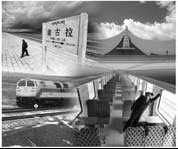Small things count in management
By Raymond Zhou (China Daily)Updated: 2007-07-14 06:53
The Qinghai-Tibet Railway has been open for a year now, but most passengers climbing up to the "Roof of the World" have opted to sidestep Xining, somewhat of a gateway to the plateau.
 It is not because the capital of Qinghai Province does not
have an abundance of tourism resources to offer. The culprit is scarcity of
tickets from Xining to Lhasa, capital of Tibet Autonomous Region.
It is not because the capital of Qinghai Province does not
have an abundance of tourism resources to offer. The culprit is scarcity of
tickets from Xining to Lhasa, capital of Tibet Autonomous Region.
Once you get off at Xining and spend a few days taking in such sceneries as Ta'er Temple and Qinghai Lake, you'll probably end up stuck here. During the summer season, there is a daily demand for 1,200-plus seats originating from Xining, but only 700-some are available.
Don't even think about getting a seat on the other Lhasa-bound trains that depart from other cities and pass through Xining. They are all booked solid through the holiday season, which runs from June to October.
This has made the tourism bonanza elusive for Qinghai and also left a typical Qinghai-Tibet travel plan disappointingly incomplete for tourists.
Granted, there are reasons why the current capacity of 3,480 tickets to Tibet cannot be raised. Train cars used in the newly built section of the railroad have to meet stringent specifications for high-altitude operation, including pumping oxygen into air-tight cars. And unlike the packed-like-sardine trains elsewhere in China, no over-booking is allowed on this route.
While emphasis on passenger safety is commendable, the inflexibility towards market fluctuation is puzzling. During off season, trains run at only 50-60 percent of capacity.
A question arises: How come a railroad with such daunting engineering difficulties, including stretching across 550 km of tundra, could be successfully built, but adjusting the number of trains to better reflect seasonal changes of the market appears to be so arduous?
I asked many railway authorities on my trip to Qinghai, but did not find a
satisfying answer. Instead, they gave me the look as if I didn't know what I was
talking about. 
I often get this kind of perplexed look when I ask about annoyances in urban management. For example, the Capital Airport has a public announcement system so loud that it drowns out a cellphone conversation. Could they tune it so that it's clearly audible but does not simulate shouting? Does the system have only two volume levels - off and shrieking?
The same goes for the city's bus service. For a while, ticket sellers were alerting passengers to the name of the next bus stop. I asked one of them why they didn't use a recorder-speaker, and she replied that it would be "noisy to the residents in nearby buildings".
I guess a lot of people shared my curiosity. Soon, the speaker was back on. And now I can hear buses pulling in from my apartment 100 meters from the street.
I know bus announcement systems can modulate their volumes because I've seen buses in other cities with volumes just loud enough for the waiting passengers. The problem seems to be that those departments run by bureaucrats rarely pay attention to the small things in customer service.
Why should a train run with more cars in the busy season and fewer cars in the off season? Why should a bus or airport speaker be easy on the ear? These may not be life-or-death issues, but it is the job of management to find them out and calibrate for the best possible result.
Xining could increase the frequency of trains to Lhasa, but that comes after local government officials made multiple requests and possibly held many coordination meetings. On most occasions, there must be mountains of complaints from the public before action is taken. When will the bureaucrat managers get proactive and resolve those minor troubles before they grow into an avalanche?
Email: raymondzhou@chinadaily.com.cn
(China Daily 07/14/2007 page4)
|
|
|
|